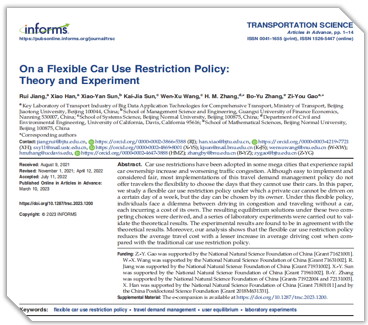Publications
- All
- Tranportation Research Part-B
- Tranportation Research Part-C
- Tranportation Science
- Tranportation Research Part-F
- PloS One
- Experimental Economics
- Cell Patterns
- Transportmetrica B: Transport Dynamics
- Tranportation Research Part-D
- IEEE TRANSACTIONS ON INTELLIGENT TRANSPORTATION SYSTEMS
- Traffic and Granular Flow
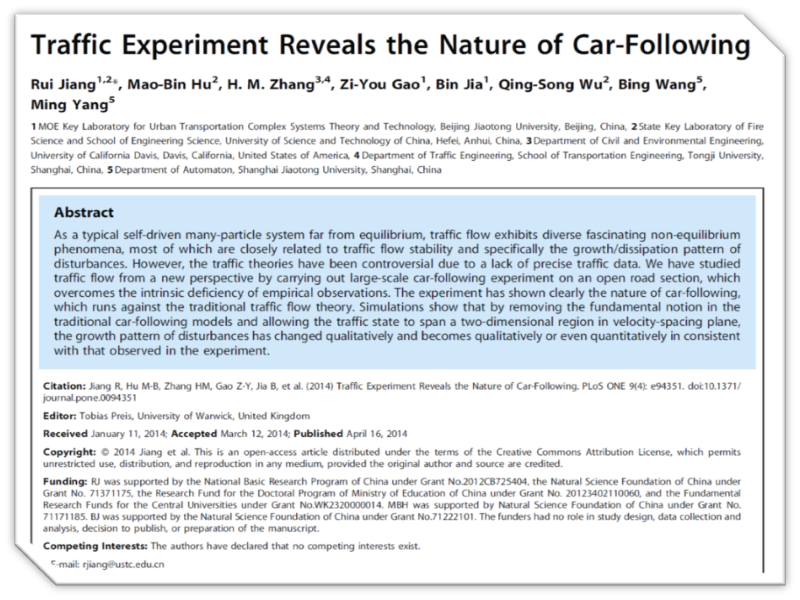
Jiang, R., Hu, M. B., Zhang, H. M., Gao, Z. Y., Jia, B., Wu, Q. S., Wang, B., Yang, M. (2014). Traffic experiment reveals the nature of car-following. PloS one, 9(4), e94351.
Traffic experiment reveals the nature of car-following
As a typical self-driven many-particle system far from equilibrium, traffic flow exhibits diverse fascinating non-equilibrium phenomena, most of which are closely related to traffic flow stability and specifically the growth/dissipation pattern of disturbances. However, the traffic theories have been controversial due to a lack of precise traffic data. We have studied traffic flow from a new perspective by carrying out large-scale car-following experiment on an open road section, which overcomes the intrinsic deficiency of empirical observations. The experiment has shown clearly the nature of car-following, which runs against the traditional traffic flow theory. Simulations show that by removing the fundamental notion in the traditional car-following models and allowing the traffic state to span a two-dimensional region in velocity-spacing plane, the growth pattern of disturbances has changed qualitatively and becomes qualitatively or even quantitatively in consistent with that observed in the experiment.
Citation: Jiang, R., Hu, M. B., Zhang, H. M., Gao, Z. Y., Jia, B., Wu, Q. S., Wang, B., Yang, M. (2014). Traffic experiment reveals the nature of car-following. PloS one, 9(4), e94351.
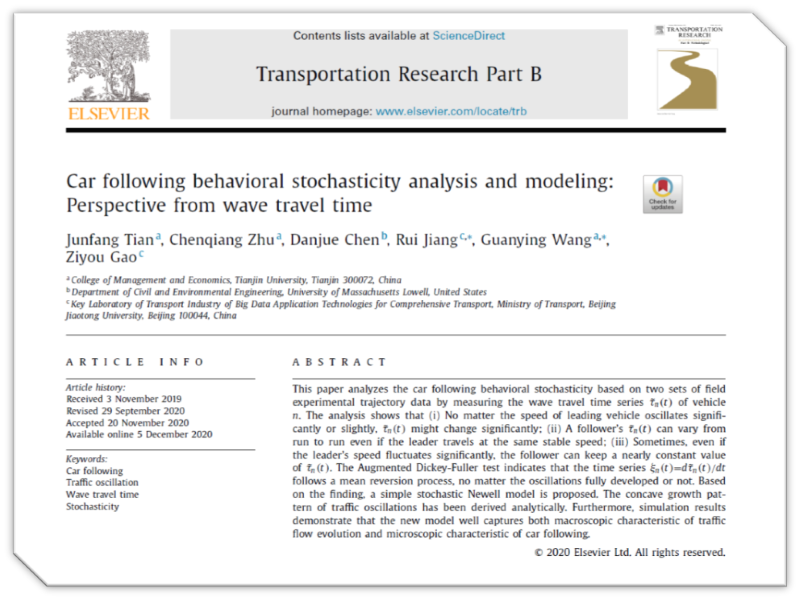
Tian, J., Zhu, C., Chen, D., Jiang, R., Wang, G., and Gao, Z. Car following behavioral stochasticity analysis and modeling: Perspective from wave travel time. Transportation Research Part B: Methodological, 143:160–176 (2021).
Car following behavioral stochasticity analysis and modeling: Perspective from wave travel time
This paper analyzes the car following behavioral stochasticity based on two sets of field experimental trajectory data by measuring the wave travel time series τ ̃_n (t) of vehicle n. The analysis shows that (i) No matter the speed of leading vehicle oscillates significantly or slightly, τ ̃_n (t) might change significantly; (ii) A follower's τ ̃_n (t) can vary from run to run even if the leader travels at the same stable speed; (iii) Sometimes, even if the leader's speed fluctuates significantly, the follower can keep a nearly constant value of τ ̃_n (t). The Augmented Dickey-Fuller test indicates that the time series ξ_n (t)=dτ ̃_n (t)/dt follows a mean reversion process, no matter the oscillations fully developed or not. Based on the finding, a simple stochastic Newell model is proposed. The concave growth pattern of traffic oscillations has been derived analytically. Furthermore, simulation results demonstrate that the new model well captures both macroscopic characteristic of traffic flow evolution and microscopic characteristic of car following.
Citation: Tian, J., Zhu, C., Chen, D., Jiang, R., Wang, G., and Gao, Z. Car following behavioral stochasticity analysis and modeling: Perspective from wave travel time. Transportation Research Part B: Methodological, 143:160–176 (2021).
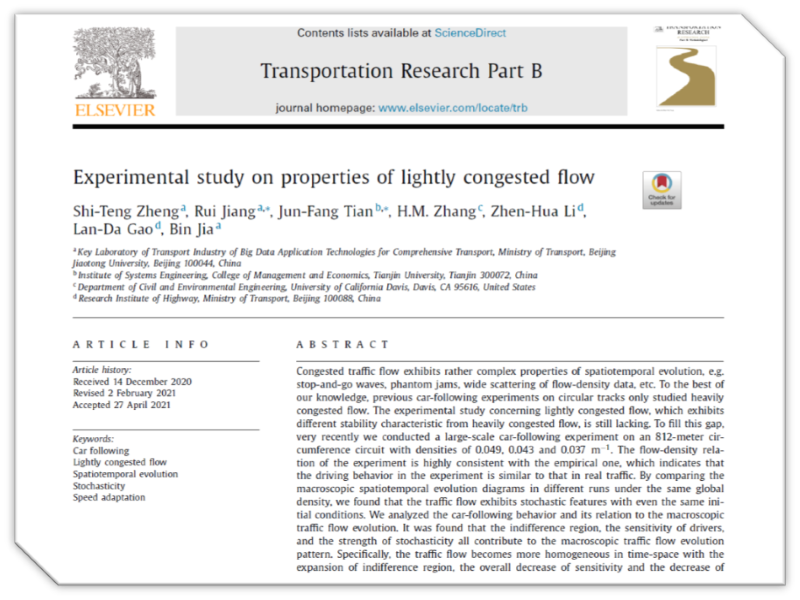
Zheng, S.-T., Jiang, R., Tian, J.-F., Zhang, H., Li, Z.-H., Gao, L.-D., and Jia, B. Experimental study on properties of lightly congested flow. Transportation Research Part B: Methodological, 149:1–19 (2021).
Experimental study on properties of lightly congested flow
Congested traffic flow exhibits rather complex properties of spatiotemporal evolution, e.g. stop-and-go waves, phantom jams, wide scattering of flow-density data, etc. To the best of our knowledge, previous car-following experiments on circular tracks only studied heavily congested flow. The experimental study concerning lightly congested flow, which exhibits different stability characteristic from heavily congested flow, is still lacking. To fill this gap, very recently we conducted a large-scale car-following experiment on an 812-meter circumference circuit with densities of 0.049, 0.043 and 0.037 m−1. The flow-density relation of the experiment is highly consistent with the empirical one, which indicates that the driving behavior in the experiment is similar to that in real traffic. By comparing the macroscopic spatiotemporal evolution diagrams in different runs under the same global density, we found that the traffic flow exhibits stochastic features with even the same initial conditions. We analyzed the car-following behavior and its relation to the macroscopic traffic flow evolution. It was found that the indifference region, the sensitivity of drivers, and the strength of stochasticity all contribute to the macroscopic traffic flow evolution pattern. Specifically, the traffic flow becomes more homogeneous in time-space with the expansion of indifference region, the overall decrease of sensitivity and the decrease of stochasticity strength. The roles of stochasticity and speed adaptation were further investigated. It was found that stronger traffic oscillations correspond to stronger stochasticity and speed adaptation. The analysis for competition between the two effects indicated that the ratio between speed adaptation effect and stochastic effect grows with the increase of the oscillation amplitude. The stochastic effect plays a dominant role in car following when the oscillation amplitude is small; its influence wanes and the speed adaptation effect grows to outweigh the influence of the stochastic effect as oscillation amplitude grows. These findings are expected to improve our understanding of the underlying mechanism that produces the spatiotemporal evolution patterns of lightly congested flow and the data collected in this study can be used to test traffic models and theories.
Citation: Zheng, S.-T., Jiang, R., Tian, J.-F., Zhang, H., Li, Z.-H., Gao, L.-D., and Jia, B.Experimental study on properties of lightly congested flow. Transportation Research Part B: Methodological, 149:1–19 (2021).
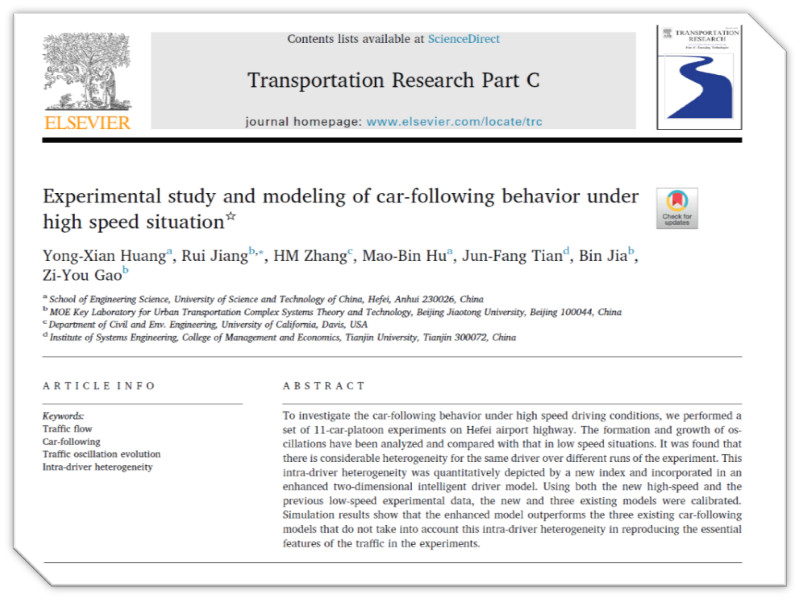
Huang, Y.-X., Jiang, R., Zhang, H., Hu, M.-B., Tian, J.-F., Jia, B., and Gao, Z.-Y. Experimental study and modeling of car-following behavior under high speed situation. Transportation Research Part C: Emerging Technologies, 97:194–215 (2018).
Experimental study and modeling of car-following behavior under high speed situation
To investigate the car-following behavior under high speed driving conditions, we performed a set of 11-car-platoon experiments on Hefei airport highway. The formation and growth of oscillations have been analyzed and compared with that in low speed situations. It was found that there is considerable heterogeneity for the same driver over different runs of the experiment. This intra-driver heterogeneity was quantitatively depicted by a new index and incorporated in an enhanced two-dimensional intelligent driver model. Using both the new high-speed and the previous low-speed experimental data, the new and three existing models were calibrated. Simulation results show that the enhanced model outperforms the three existing car-following models that do not take into account this intra-driver heterogeneity in reproducing the essential features of the traffic in the experiments.
Citation: Huang, Y.-X., Jiang, R., Zhang, H., Hu, M.-B., Tian, J.-F., Jia, B., and Gao, Z.-Y. Experimental study and modeling of car-following behavior under high speed situation. Transportation Research Part C: Emerging Technologies, 97:194–215 (2018).
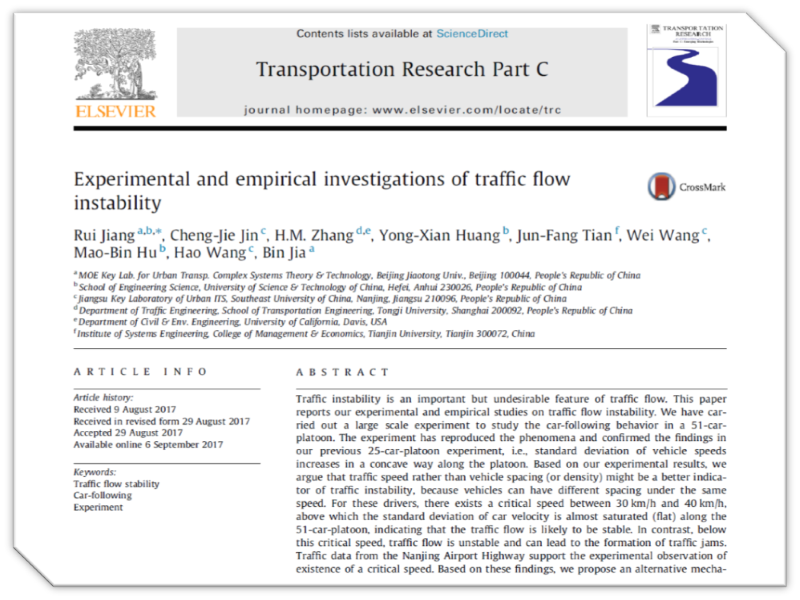
Jiang, R., Jin, C.-J., Zhang, H., Huang, Y.-X., Tian, J.-F., Wang, W., Hu, M.-B., Wang, H., and Jia, B. Experimental and empirical investigations of traffic flow instability. Transportation Research Part C: Emerging Technologies, 94:83–98 (2018).
Experimental and empirical investigations of traffic flow instability
Traffic instability is an important but undesirable feature of traffic flow. This paper reports our experimental and empirical studies on traffic flow instability. We have carried out a large scale experiment to study the car-following behavior in a 51-car-platoon. The experiment has reproduced the phenomena and confirmed the findings in our previous 25-car-platoon experiment, i.e., standard deviation of vehicle speeds increases in a concave way along the platoon. Based on our experimental results, we argue that traffic speed rather than vehicle spacing (or density) might be a better indicator of traffic instability, because vehicles can have different spacing under the same speed. For these drivers, there exists a critical speed between 30 km/h and 40 km/h, above which the standard deviation of car velocity is almost saturated (flat) along the 51-car-platoon, indicating that the traffic flow is likely to be stable. In contrast, below this critical speed, traffic flow is unstable and can lead to the formation of traffic jams. Traffic data from the Nanjing Airport Highway support the experimental observation of existence of a critical speed. Based on these findings, we propose an alternative mechanism of traffic instability: the competition between stochastic factors and the so-called speed adaptation effect, which can better explain the concave growth of speed standard deviation in traffic flow.
Citation: Jiang, R., Jin, C.-J., Zhang, H., Huang, Y.-X., Tian, J.-F., Wang, W., Hu, M.-B., Wang, H., and Jia, B. Experimental and empirical investigations of traffic flow instability. Transportation Research Part C: Emerging Technologies, 94:83–98 (2018).
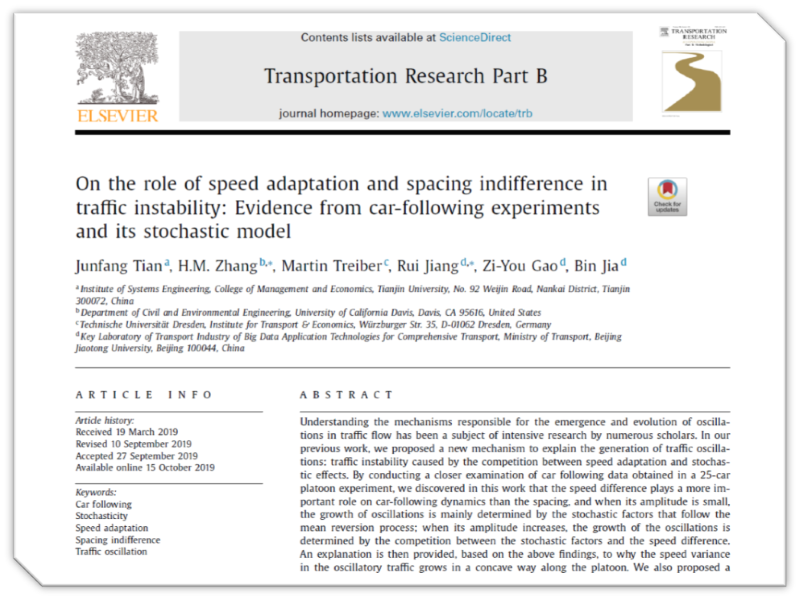
Tian, J., Zhang, H. M., Treiber, M., Jiang, R., Gao, Z. Y., & Jia, B. (2019). On the role of speed adaptation and spacing indifference in traffic instability: Evidence from car-following experiments and its stochastic model. Transportation research part B: methodological, 129, 334-350.
On the role of speed adaptation and spacing indifference in traffic instability: Evidence from car-following experiments and its stochastic model
Understanding the mechanisms responsible for the emergence and evolution of oscillations in traffic flow has been a subject of intensive research by numerous scholars. In our previous work, we proposed a new mechanism to explain the generation of traffic oscillations: traffic instability caused by the competition between speed adaptation and stochastic effects. By conducting a closer examination of car following data obtained in a 25-car platoon experiment, we discovered in this work that the speed difference plays a more important role on car-following dynamics than the spacing, and when its amplitude is small, the growth of oscillations is mainly determined by the stochastic factors that follow the mean reversion process; when its amplitude increases, the growth of the oscillations is determined by the competition between the stochastic factors and the speed difference. An explanation is then provided, based on the above findings, to why the speed variance in the oscillatory traffic grows in a concave way along the platoon. We also proposed a mode-switching stochastic car-following model that incorporates the speed adaptation and spacing indifference behavior of drivers, which captures the observed characteristics of oscillation and discharge rate. Finally, our sensitivity analysis shows that the influence on oscillation growth and discharge rate is small by the reaction delay but large by the indifference region boundary.
Citation: Tian, J., Zhang, H. M., Treiber, M., Jiang, R., Gao, Z. Y., & Jia, B. (2019). On the role of speed adaptation and spacing indifference in traffic instability: Evidence from car-following experiments and its stochastic model. Transportation research part B: methodological, 129, 334-350.
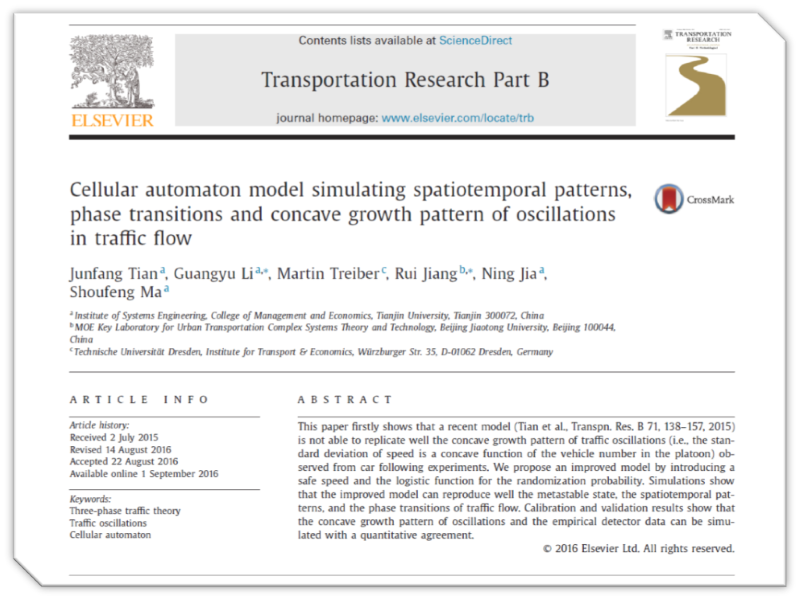
Tian, J. , Rui, J. , Li, G. , Treiber, M. , & Ma, S. . (2016). Cellular automaton model simulating spatiotemporal patterns, phase transitions and evolution concavity in traffic flow. Transportation Research Part B Methodological, 93, 560-575.
Cellular automaton model simulating spatiotemporal patterns, phase transitions and evolution concavity in traffic flow
This paper firstly show that a recent model (Tian et al., Transpn. Res. B 71, 138-157, 2015) is not able to well replicate the evolution concavity in traffic flow, i.e. the standard deviation of vehicles increases in a concave/linear way along the platoon. Then we propose an improved model by introducing the safe speed, the logistic function of the randomization probability, and small randomization deceleration for low-speed vehicles into the model. Simulations show that the improved model can well reproduce the metastable states, the spatiotemporal patterns, the phase transition behaviors of traffic flow, and the evolution concavity of traffic oscillations. Validating results show that the empirical time series of traffic speed obtained from Floating Car Data can be well simulated as well.
Citation: Tian, J. , Rui, J. , Li, G. , Treiber, M. , & Ma, S. . (2016). Cellular automaton model simulating spatiotemporal patterns, phase transitions and evolution concavity in traffic flow. Transportation Research Part B Methodological, 93, 560-575.
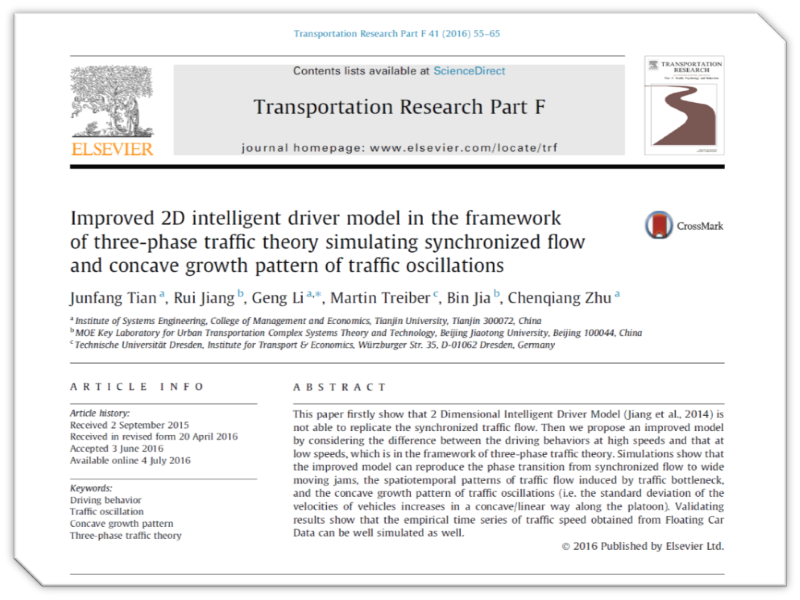
Tian, J. , Jiang, R. , Li, G. , Treiber, M. , Jia, B. , & Zhu, C. . (2016). Improved 2d intelligent driver model in the framework of three-phase traffic theory simulating synchronized flow and concave growth pattern of traffic oscillations. Transportation Research Part F Traffic Psychology & Behaviour, 41(pt.A), 55-65.
Improved 2d intelligent driver model in the framework of three-phase traffic theory simulating synchronized flow and concave growth pattern of traffic oscillations
This paper firstly show that 2 Dimensional Intelligent Driver Model (Jiang et al., 2014) is not able to replicate the synchronized traffic flow. Then we propose an improved model by considering the difference between the driving behaviors at high speeds and that at low speeds, which is in the framework of three-phase traffic theory. Simulations show that the improved model can reproduce the phase transition from synchronized flow to wide moving jams, the spatiotemporal patterns of traffic flow induced by traffic bottleneck, and the concave growth pattern of traffic oscillations (i.e. the standard deviation of the velocities of vehicles increases in a concave/linear way along the platoon). Validating results show that the empirical time series of traffic speed obtained from Floating Car Data can be well simulated as well.
Citation: Tian, J. , Jiang, R. , Li, G. , Treiber, M. , Jia, B. , & Zhu, C. . (2016). Improved 2d intelligent driver model in the framework of three-phase traffic theory simulating synchronized flow and concave growth pattern of traffic oscillations. Transportation Research Part F Traffic Psychology & Behaviour, 41(pt.A), 55-65.
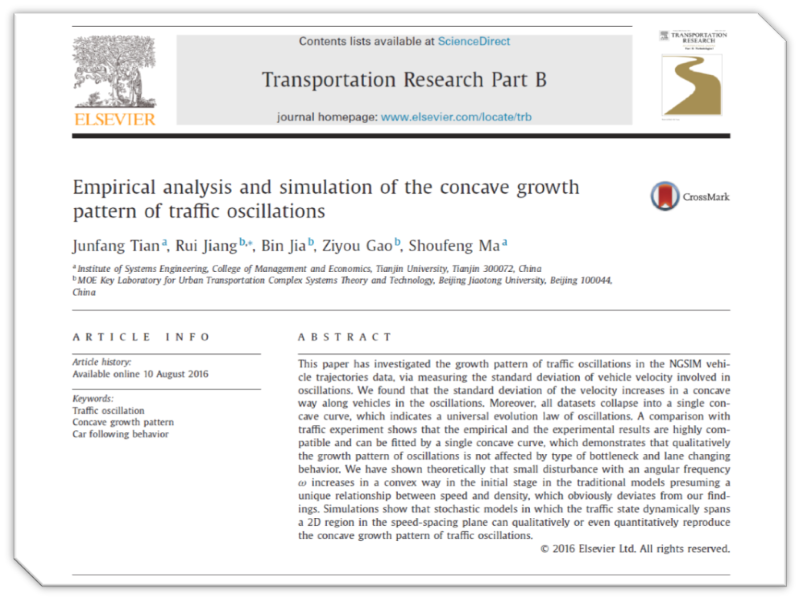
Junfang Tian, Rui Jiang, Bin Jia, Ziyou Gao, Shoufeng Ma (2015). Empirical analysis and simulation of the evolution concavity of traffic oscillations. Transportation Research Part B: Methodological, 93, 338–354.
Empirical analysis and simulation of the evolution concavity of traffic oscillations
This paper has investigated the growth pattern of traffic oscillations in the NGSIM vehicle trajectories data, via measuring the standard deviation of vehicle velocity involved in oscillations. We found that the standard deviation of the velocity increases in a concave way along vehicles in the oscillations. Moreover, all datasets collapse into a single concave curve, which indicates a universal evolution law of oscillations. A comparison with traffic experiment shows that the empirical and the experimental results are highly compatible and can be fitted by a single concave curve, which demonstrates that qualitatively the growth pattern of oscillations is not affected by type of bottleneck and lane changing behavior. We have shown theoretically that small disturbances increase in a convex way in the initial stage in the traditional models presuming a unique relationship between speed and density, which obviously deviates from our findings. Simulations show that stochastic models in which the traffic state dynamically spans a 2D region in the speed-spacing plane can qualitatively or even quantitatively reproduce the concave growth pattern of traffic oscillations.
Citation: Junfang Tian, Rui Jiang, Bin Jia, Ziyou Gao, Shoufeng Ma (2015). Empirical analysis and simulation of the evolution concavity of traffic oscillations. Transportation Research Part B: Methodological, 93, 338–354.
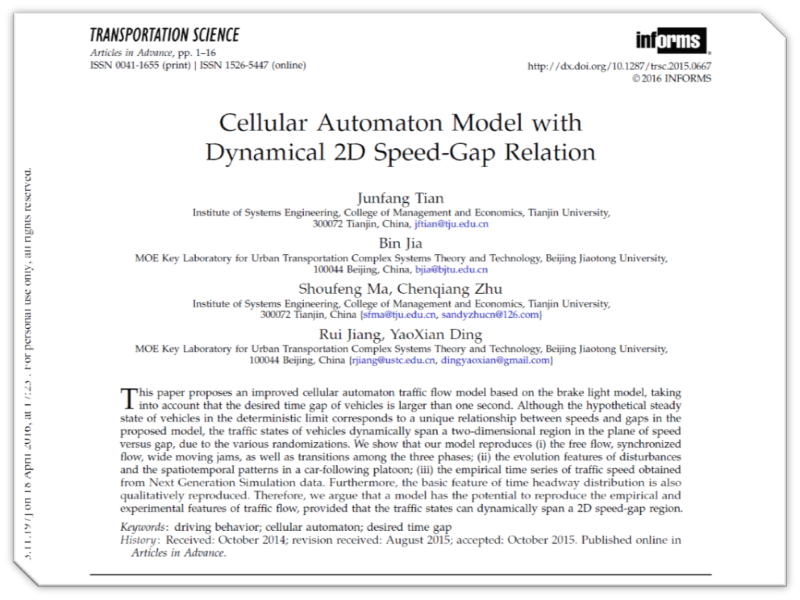
Junfang Tian, Bin Jia, Shoufeng Ma, Chenqiang Zhu, Rui Jiang, YaoXian Ding (2017) Cellular Automaton Model with Dynamical 2D Speed-Gap Relation. Transportation Science, 51(3):807-822.
Cellular Automaton Model with Dynamical 2D Speed-Gap Relation
This paper proposes an improved cellular automaton traffic flow model based on the brake light model, taking into account that the desired time gap of vehicles is larger than one second. Although the hypothetical steady state of vehicles in the deterministic limit corresponds to a unique relationship between speeds and gaps in the proposed model, the traffic states of vehicles dynamically span a two-dimensional region in the plane of speed versus gap, due to the various randomizations. We show that our model reproduces (i) the free flow, synchronized flow, wide moving jams, as well as transitions among the three phases; (ii) the evolution features of disturbances and the spatiotemporal patterns in a car-following platoon; (iii) the empirical time series of traffic speed obtained from Next Generation Simulation data. Furthermore, the basic feature of time headway distribution is also qualitatively reproduced. Therefore, we argue that a model has the potential to reproduce the empirical and experimental features of traffic flow, provided that the traffic states can dynamically span a 2D speed-gap region.
Citation: Junfang Tian, Bin Jia, Shoufeng Ma, Chenqiang Zhu, Rui Jiang, YaoXian Ding (2017) Cellular Automaton Model with Dynamical 2D Speed-Gap Relation. Transportation Science, 51(3):807-822.
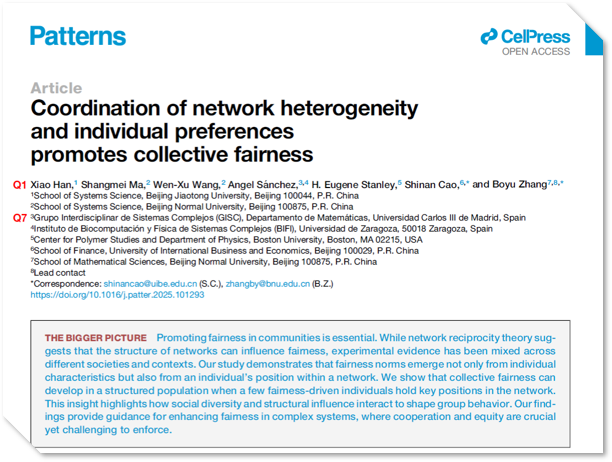
X, Han.c, S, Ma., WX, Wang., A, Sanchez., H.E, Stanley., S, Cap. and B, Zhang. Coordination of network heterogeneityand individual preferences promotes collective fairness Patterns (2025).
There are intensive debates about whether heterogeneous networks promote prosocial behaviors such asfairness and cooperation. Theoretical models predict that network heterogeneity plays a positive role, butthis prediction has not been validated by experiments. We reconcile this debate by conducting experimentswith two-stage ultimatum games on networks. In the first stage, we identify responders with strong fairnesspreferences, referred to as leaders. In the second stage, when leaders occupy high-degree nodes in a het.erogeneous network, their ability to motivate fairness among neighboring proposers is amplified, and collective fairness is facilitated. We propose an evolutionary game model and an agent-based simulation framework that capture the microscopic mechanisms underlving the networked experiments, Our experimentsmodel, and simulations suggest that network reciprocity is achievable but reguires coordinated interactionsbetween diferent prosocial inclinations of individuals and social network structures.
url:
Citation: Han, X., Ma, S., WX, Wang., Sanchez, A., Stanley, H.E., Cap, S. and Zhang, B. Coordination of network heterogeneityand individual preferences promotes collective fairness. Patterns (2025).
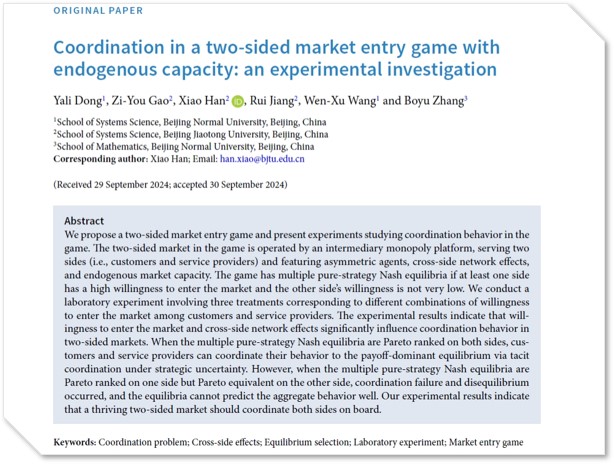
Y, Dong., ZY, Gao., X, Han., R, Jiang., WX, Wang and B, Zhang. Coordination in a two-sided market entry game with endogenous capacity: an experimental investigation Experimental Economics 1-24(2025).
Coordination in a two-sided market entry game with endogenous capacity: an experimental investigation
We propose a two-sided market entry game and present experiments studying coordination behavior in the game. The two-sided market in the game is operated by an intermediary monopoly platform, serving two sides (i.e., customers and service providers) and featuring asymmetric agents, cross-side network effects, and endogenous market capacity. The game has multiple pure-strategy Nash equilibria if at least one side has a high willingness to enter the market and the other side’s willingness is not very low. We conduct a laboratory experiment involving three treatments corresponding to different combinations of willingness to enter the market among customers and service providers. The experimental results indicate that willingness to enter the market and cross-side network effects significantly influence coordination behavior in two-sided markets. When the multiple pure-strategy Nash equilibria are Pareto ranked on both sides, customers and service providers can coordinate their behavior to the payoff-dominant equilibrium via tacit coordination under strategic uncertainty. However, when the multiple pure-strategy Nash equilibria are Pareto ranked on one side but Pareto equivalent on the other side, coordination failure and disequilibrium occurred, and the equilibria cannot predict the aggregate behavior well. Our experimental results indicate that a thriving two-sided market should coordinate both sides on board.
Citation: Dong, Y., Gao, ZY., Han, X., Jiang, R., Wang, WX. and Zhang, B. Coordination in a two-sided market entry game with endogenous capacity: an experimental investigation. Experimental Economics 1–24 (2025).

Rui Jiang , MaoBin Hu , H.M.Zhang , ZiYou Gao , Bin Jia , Qingsong Wu (2015) On some experimental features of car-following behavior and how to model them. Transportation Research Part B: Methodological, 80, 338-354.
On some experimental features of car-following behavior and how to model them
We have carried out car-following experiments with a 25-car-platoon on an open road section to study the relation between a car’s speed and its spacing under various traffic conditions, in the hope to resolve a controversy surrounding this fundamental relation of vehicular traffic. In this paper we extend our previous analysis of these experiments, and report new experimental findings. In particular, we reveal that the platoon length (hence the average spacing within a platoon) might be significantly different even if the average velocity of the platoon is essentially the same. The findings further demonstrate that the traffic states span a 2D region in the speed-spacing (or density) plane. The common practice of using a single speed-spacing curve to model vehicular traffic ignores the variability and imprecision of human driving and is therefore inadequate. We have proposed a car-following model based on a mechanism that in certain ranges of speed and spacing, drivers are insensitive to the changes in spacing when the velocity differences between cars are small. It was shown that the model can reproduce the experimental results well.
Citation: Rui Jiang , MaoBin Hu , H.M.Zhang , ZiYou Gao , Bin Jia , Qingsong Wu (2015) On some experimental features of car-following behavior and how to model them. Transportation Research Part B: Methodological, 80, 338-354.
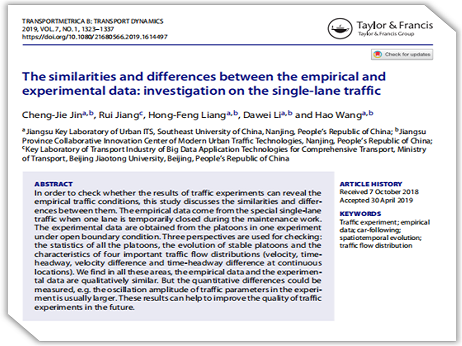
Cheng-Jie Jin, Rui Jiang, Hong-Feng Liang, Dawei Li and Hao Wang. The similarities and differences between the empirical and experimental data: investigation on the single-lane traffic Transportmetrica B: Transport Dynamics (2019).
In order to check whether the results of traffic experiments can reveal the empirical traffic conditions, this
study discusses the similarities and differences between them. The empirical data come from the special single-lane traffic when one lane is temporarily
closed during the maintenance work.The experimental data are obtained from the platoons in one experiment under open boundary condition. Three perspectives are used for checking:
the statistics of all the platoons, the evolution of stable platoons and the characteristics of four important traffic flow distributions (velocity,
time,headway, velocity difference and time-headway difference at continuous locations). We find in all these areas, the empirical data and the experimental data are qualitatively similar.
But the quantitative differences could be measured, e.g. the oscillation amplitude of traffic parameters in the experiment is usually larger. These results can help to improve the quality of
traffic experiments in the future.
url:
Citation: Cheng-Jie Jin, Rui Jiang, Hong-Feng Liang, Dawei Li and Hao Wang. The similarities and differences between the empirical and experimental data: investigation on the single-lane traffic Transportmetrica B: Transport Dynamics (2019).
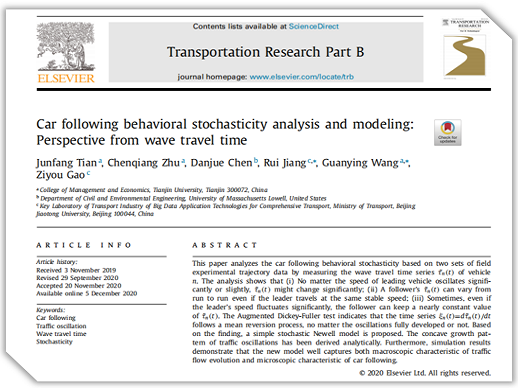
Junfang Tian, Chenqiang Zhu, Danjue Chen, Rui Jiang, Guanying Wang,Ziyou Gao. Car following behavioral stochasticity analysis and modeling:Perspective from wave travel time Transportation Research: Part B (2021).
This paper analyzes the car following behavioral stochasticity based on two sets of field experimental trajectory data by measuring the wave travel time series \(\tilde{\tau}_n(t)\) of vehicle \(n\). The analysis shows that (i) No matter the speed of leading vehicle oscillates significantly or slightly, \(\tilde{\tau}_n(t)\) might change significantly; (ii) A follower's \(\tilde{\tau}_n(t)\) can vary from run to run even if the leader travels at the same stable speed; (iii) Sometimes, even if the leader's speed fluctuates significantly, the follower can keep a nearly constant value of \(\tilde{\tau}_n(t)\). The Augmented Dickey-Fuller test indicates that the time series \(\xi_n(t)=d\tilde{\tau}_n(t)/dt\) follows a mean reversion process, no matter the oscillations fully developed or not. Based on the finding, a simple stochastic Newell model is proposed. The concave growth pattern of traffic oscillations has been derived analytically. Furthermore, simulation results demonstrate that the new model well captures both macroscopic characteristic of traffic flow evolution and microscopic characteristic of car following.
url:
Citation: Junfang Tian, Chenqiang Zhu, Danjue Chen, Rui Jiang, Guanying Wang,Ziyou Gao. Car following behavioral stochasticity analysis and modeling:Perspective from wave travel time. Transportation Research: Part B (2021).
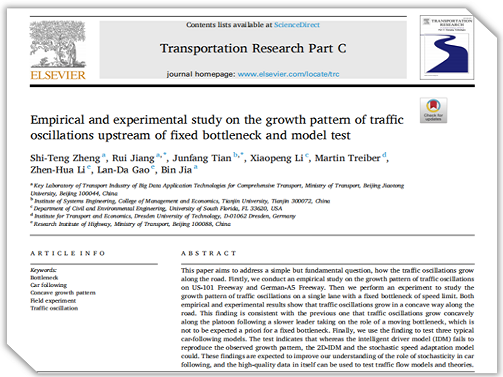
Shi-Teng Zheng, Rui Jiang, Junfang Tian, Xiaopeng Li, Martin Treiber, Zhen-Hua Li, Lan-Da Gao, Bin Jia. Empirical and experimental study on the growth pattern of traffic oscillations upstream of fixed bottleneck and model test Transportation Research: Part C (2022).
This paper analyzes the car following behavioral stochasticity based on two sets of field experimental trajectory data by measuring the wave travel time series of vehicle . The analysis shows that (i) No matter the speed of leading vehicle oscillates significantly or slightly, might change significantly; (ii) A follower's can vary from run to run even if the leader travels at the same stable speed; (iii) Sometimes, even if the leader's speed fluctuates significantly, the follower can keep a nearly constant value of . The Augmented Dickey-Fuller test indicates that the time series follows a mean reversion process, no matter the oscillations fully developed or not. Based on the finding, a simple stochastic Newell model is proposed. The concave growth pattern of traffic oscillations has been derived analytically. Furthermore, simulation results demonstrate that the new model well captures both macroscopic characteristic of traffic flow evolution and microscopic characteristic of car following.
url:
Citation: Shi-Teng Zheng, Rui Jiang, Junfang Tian, Xiaopeng Li, Martin Treiber, Zhen-Hua Li, Lan-Da Gao, Bin Jia. Empirical and experimental study on the growth pattern of traffic oscillations upstream of fixed bottleneck and model test Transportation Research: Part C (2022).
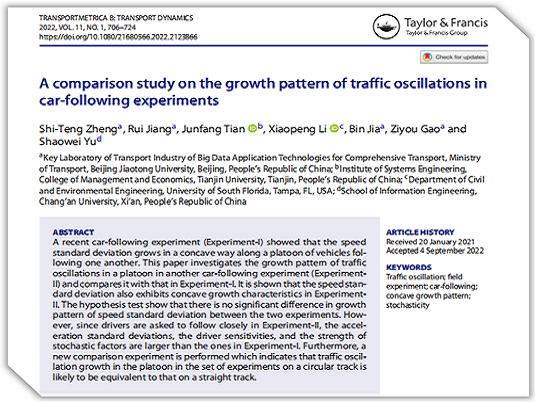
Shi-Teng Zheng, Rui Jiang, Junfang Tian, Xiaopeng Li, Bin Jia, Ziyou Gao and Shaowei Yu. A comparison study on the growth pattern of traffic oscillations in car-following experiments Transportmetrica B: Transport Dynamics (2022).
A recent car-following experiment (Experiment-I) showed that the speed standard deviation grows in a concave way along a platoon of vehicles following one another. This paper investigates the growth pattern of traffic oscillations in a platoon in another car-following experiment (Experiment-II) and compares it with that in Experiment-I. It is shown that the speed standard deviation also exhibits concave growth characteristics in Experiment-II. The hypothesis test show that there is no significant difference in growth pattern of speed standard deviation between the two experiments. However, since drivers are asked to follow closely in Experiment-II, the acceleration standard deviations, the driver sensitivities, and the strength of stochastic factors are larger than the ones in Experiment-I. Furthermore, a new comparison experiment is performed which indicates that traffic oscillation growth in the platoon in the set of experiments on a circular track is likely to be equivalent to that on a straight track.
url:
Citation: Shi-Teng Zheng, Rui Jiang, Junfang Tian, Xiaopeng Li, Bin Jia, Ziyou Gao and Shaowei Yu. A comparison study on the growth pattern of traffic oscillations in car-following experiments Transportmetrica B: Transport Dynamics (2022).
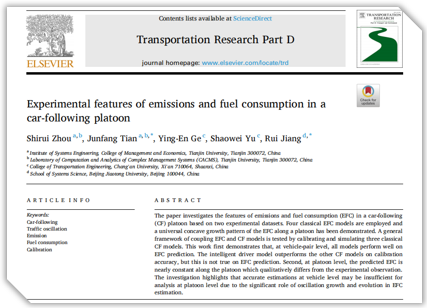
Shinru Zhou, Junfang Tian, Ying-En Ge, Shaowei Yu, Rui Jiang. Experimental features of emissions and fuel consumption in a car-following platoon Transportation Research: Part D (2023).
The paper investigates the features of emissions and fuel consumption (EFC) in a car-following platoon. Experiments based on two different car-following models and a natural concave growth pattern of the EFC along a platoon has been observed. A general conclusion of the study is that the EFC along a platoon is mainly affected by the speed standard deviation (SSD) of the platoon. The EFC model, which is based on the SSD, is developed and the model is validated by the experimental data. The results indicate that the EFC along a platoon is mainly constant along the platoon which qualitatively differs from the experimental observation. The analysis shows that the EFC along a platoon is mainly affected by the significant role of oscillation growth and reduction in EFC estimation.
url:
Citation: Shinru Zhou, Junfang Tian, Ying-En Ge, Shaowei Yu, Rui Jiang. Experimental features of emissions and fuel consumption in a car-following platoon Transportation Research: Part D (2023).
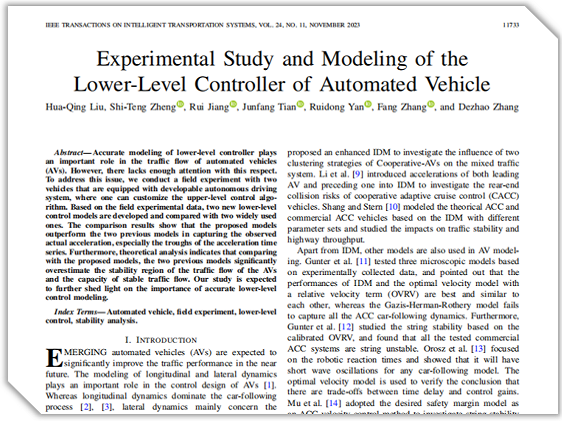
Hua-Qing Liu, Shi-Teng Zheng, Rui Jiang, Junfang Tian, Ruidong Yan, Fang Zhang, and Dezhao Zhang. Experimental Study and Modeling of the Lower-Level Controller of Automated Vehicle IEEE TRANSACTIONS ON INTELLIGENT TRANSPORTATION SYSTEMS (2023).
Accurate modeling of lower-level controller plays an important role in the traffic flow of automated vehicles (AVs). However, there lacks enough attention with this respect. To address this issue, we conduct a field experiment with two vehicles that are equipped with developable autonomous driving system, where one can customize the upper-level control algorithm. Based on the field experimental data, two new lower-level control models are developed and compared with two widely used ones. The comparison results show that the proposed models outperform the two previous models in capturing the observed actual acceleration, especially the troughs of the acceleration time series. Furthermore, theoretical analysis indicates that comparing with the proposed models, the two previous models significantly overestimate the stability region of the traffic flow of the AVs and the capacity of stable traffic flow. Our study is expected to further shed light on the importance of accurate lower-level control modeling.
url:
Citation: Hua-Qing Liu, Shi-Teng Zheng, Rui Jiang, Junfang Tian, Ruidong Yan, Fang Zhang, and Dezhao Zhang. Experimental Study and Modeling of the Lower-Level Controller of Automated Vehicle IEEE TRANSACTIONS ON INTELLIGENT TRANSPORTATION SYSTEMS (2023).
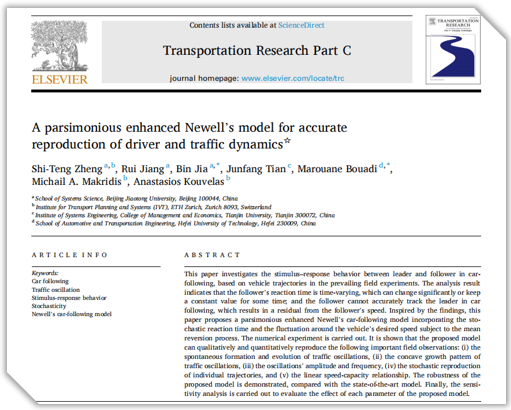
Shi-Teng Zheng, Rui Jiang, Bin Jia, Junfang Tian, Marouane Bouadi, Michal A. Makridis, Anastasios Kouvelas. A parsimonious enhanced Newell’s model for accurate reproduction of driver and traffic dynamics Transportation Research: Part C (2023).
url:
Citation: Shi-Teng Zheng, Rui Jiang, Bin Jia, Junfang Tian, Marouane Bouadi, Michal A. Makridis, Anastasios Kouvelas. A parsimonious enhanced Newell’s model for accurate reproduction of driver and traffic dynamics. Transportation Research: Part C (2023).
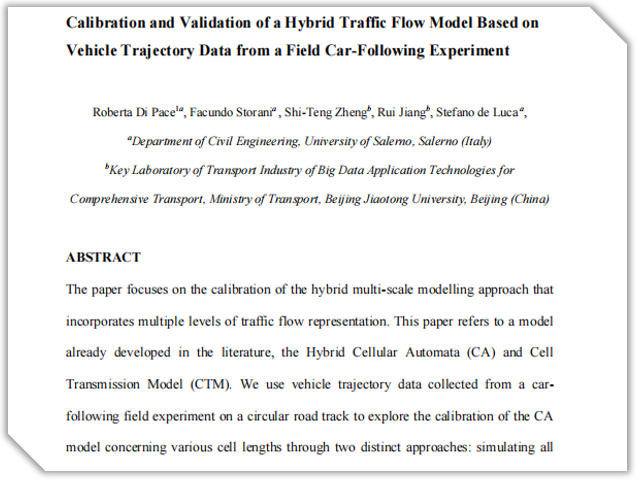
Roberta Di Pace, Facundo Storani, Shi-Teng Zheng, Rui Jiang, Stefano de Luca. Calibration and Validation of a Hybrid Traffic Flow Model Based on Vehicle Trajectory Data from a Field Car-Following Experiment Transportmetrica B: Transport Dynamics (2024).
The paper focuses on the calibration of the hybrid multi-scale modelling approach that incorporates multiple levels of traffic flow representation. This paper refers to a model already developed in the literature, the Hybrid Cellular Automata (CA) and Cell Transmission Model (CTM). We use vehicle trajectory data collected from a car-following field experiment on a circular road track to explore the calibration of the CA model concerning various cell lengths through two distinct approaches: simulating all vehicles within the closed loop and simulating each vehicle using data obtained from its respective follower. We also evaluate different methods for the CTM calibration with respect to the CA model. The major findings are: 1) the calibrated parameters obtained using the simulated leader approach display greater regularity across different cell lengths; 2) the Constrained Squared Error [CsqE] method for macroscopic calibrations yielded promising results, showcasing the lowest sum of squared errors between fundamental diagrams.
url:
Citation: Roberta Di Pace, Facundo Storani, Shi-Teng Zheng, Rui Jiang, Stefano de Luca. Calibration and Validation of a Hybrid Traffic Flow Model Based on Vehicle Trajectory Data from a Field Car-Following Experiment. Transportmetrica B: Transport Dynamics (2024).
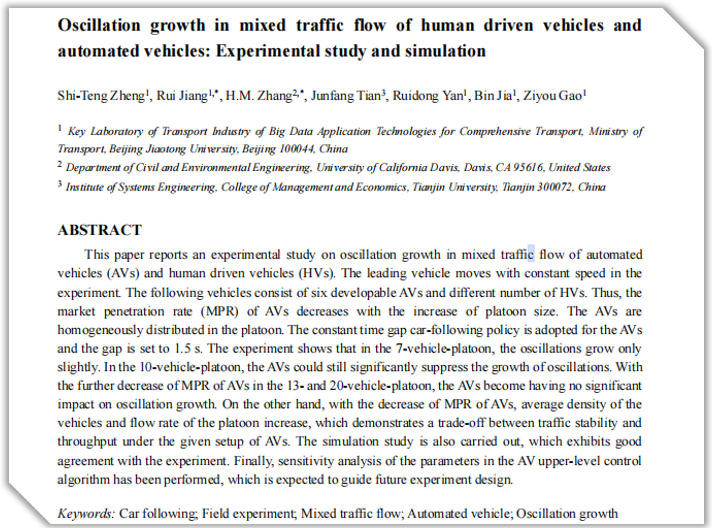
Shi-Teng Zheng, Rui Jiang, H.M. Zhang, Junfang Tian, Ruidong Yan, Bin Jia, Ziyou Gao. Oscillation growth in mixed traffic flow of human driven vehicles and automated vehicles: Experimental study and simulation Traffic and Granular Flow (2024).
This paper reports an experimental study on oscillation growth in mixed traffic flow of automated vehicles (AVs) and human driven vehicles (HVs). The leading vehicle moves with constant speed in the experiment. The following vehicles consist of six developable AVs and different number of HVs. Thus, the market penetration rate (MPR) of AVs decreases with the increase of platoon size. The AVs are homogeneously distributed in the platoon. The constant time gap car-following policy is adopted for the AVs and the gap is set to 1.5 s. The experiment shows that in the 7-vehicle-platoon, the oscillations grow only slightly. In the 10-vehicle-platoon, the AVs could still significantly suppress the growth of oscillations. With the further decrease of MPR of AVs in the 13- and 20-vehicle-platoon, the AVs become having no significant impact on oscillation growth. On the other hand, with the decrease of MPR of AVs, average density of the trucks and flow rate of the platoon increase, which demonstrates a trade-off between traffic stability and throughput under the given setup of AVs. The simulation study is also carried out, which exhibits good agreement with the experiment. Finally, sensitivity analysis of the parameters in the AV upper-level control algorithm has been performed, which is expected to guide future experiment design.
url:
Citation: Shi-Teng Zheng, Rui Jiang, H.M. Zhang, Junfang Tian, Ruidong Yan, Bin Jia, Ziyou Gao. Oscillation growth in mixed traffic flow of human driven vehicles and automated vehicles: Experimental study and simulation Traffic and Granular Flow (2024).
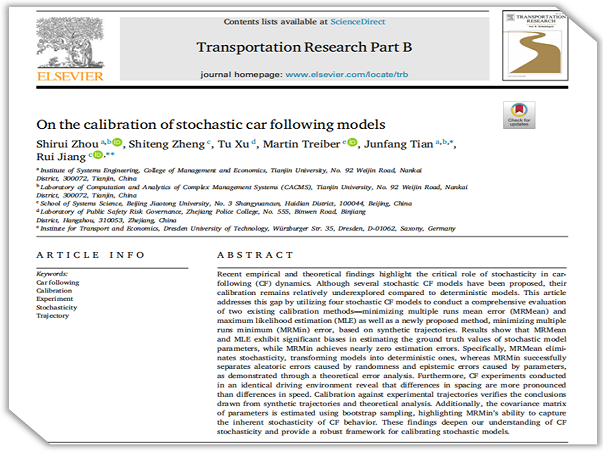
Shirui Zhou, Shiteng Zheng, Tu Xu, Martin Treiber, Junfang Tian, Rui Jiang. On the calibration of stochastic car following models Transportation Research: Part B (2025).
Recent empirical and theoretical findings highlight the critical role of stochasticity in car-following (CF) dynamics. Although several stochastic CF models have been proposed, their calibration remains relatively underexplored compared to deterministic models. This article addresses this gap by utilizing four stochastic CF models to conduct a comprehensive evaluation of two existing calibration methods—minimizing multiple runs mean error (MRMean) and maximum likelihood estimation (MLE) as well as a newly proposed method, minimizing multiple runs minimum (MRMin) error, based on synthetic trajectories. Results show that MRMean and MLE exhibit significant biases in estimating the ground truth values of stochastic model parameters, while MRMin achieves nearly zero estimation errors. Specifically, MRMean eliminates stochasticity, transforming models into deterministic ones, whereas MRMin successfully separates aleatoric errors caused by randomness and epistemic errors caused by parameters, as demonstrated through a theoretical error analysis. Furthermore, CF experiments conducted in an identical driving environment reveal that differences in spacing are more pronounced than differences in speed. Calibration against experimental trajectories verifies the conclusions drawn from synthetic trajectories and theoretical analysis. Additionally, the covariance matrix of parameters is estimated using bootstrap sampling, highlighting MRMin’s ability to capture the inherent stochasticity of CF behavior. These findings deepen our understanding of CF stochasticity and provide a robust framework for calibrating stochastic models.
url:
Citation: Shirui Zhou, Shiteng Zheng, Tu Xu, Martin Treiber, Junfang Tian, Rui Jiang. On the calibration of stochastic car following models. Transportation Research: Part B (2025).
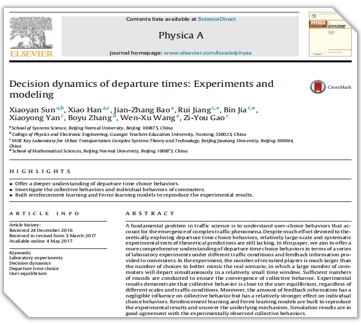
Xiaoyan Sun, Xiao Han, Jian-Zhang Bao, Rui Jiang, Bin Jia, Xiaoyong Yan, Boyu Zhang, Wen-Xu Wang, Zi-You Gao. Decision dynamics of departure times: Experiments and modeling Physica A.
A fundamental problem in traffic science is to understand user-choice behaviors that account for the emergence of complex traffic phenomena. Despite much effort devoted to the theoretically exploring departure time choice behaviors, relatively large-scale and systematic experimental tests of theoretical predictions are still lacking. In this paper, we aim to offer a more comprehensive understanding of departure time choice behaviors in terms of a series of laboratory experiments under different traffic conditions and feedback information provided to commuters. In the experiment, the number of recruited players is much larger than the number of choices to better mimic the real scenario, in which a large number of commuters will depart simultaneously in a relatively small time window. Sufficient numbers of rounds are conducted to ensure the convergence of collective behavior. Experimental results demonstrate that collective behavior is close to the user equilibrium, regardless of different scales and traffic conditions. Moreover, the amount of feedback information has a negligible influence on collective behavior but has a relatively stronger effect on individual choice behaviors. Reinforcement learning and Fermi learning models are built to reproduce the experimental results and uncover the underlying mechanism. Simulation results are in good agreement with the experimentally observed collective behaviors.
url:
Citation:Xiaoyan Sun, Xiao Han, Jian-Zhang Bao, Rui Jiang, Bin Jia, Xiaoyong Yan, Boyu Zhang, Wen-Xu Wang, Zi-You Gao. Decision dynamics of departure times: Experiments and modeling Physica A.
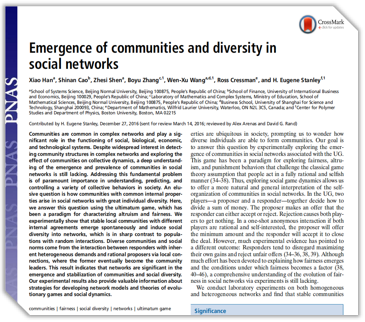
Xiao Han, Shinan Cao, Zhesi Shen, Boyu Zhang, Wen-Xu Wang, Ross Cressman, and H. Eugene Stanley. Emergence of communities and diversity in social networks PNAS.
url:
Citation: Shirui Zhou, Shiteng Zheng, Tu Xu, Martin Treiber, Junfang Tian, Rui Jiang. On the calibration of stochastic car following models. Transportation Research: Part B (2025).
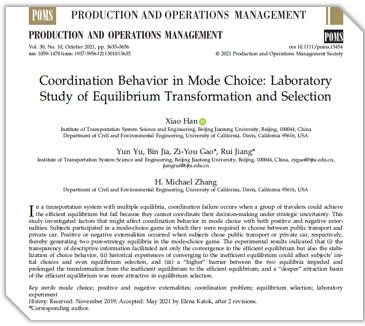
Xiao Han, Yun Yu, Bin Jia, Zi-You Gao, Rui Jiang, H. Michael Zhang. Coordination Behavior in Mode Choice: Laboratory Study of Equilibrium Transformation and Selection PRODUCTION AND OPERATIONS MANAGEMENT.
url:
Citation: Shirui Zhou, Shiteng Zheng, Tu Xu, Martin Treiber, Junfang Tian, Rui Jiang. On the calibration of stochastic car following models. Transportation Research: Part B (2025).
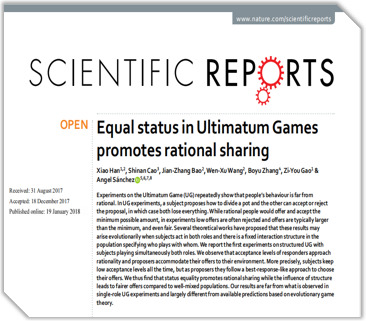
Xiao Han, Shinan Cao, Jian-Zhang Bao, Wen-Xu Wang, Boyu Zhang, Zi-You Gao & Ross Cressman. Equal status in Ultimatum Games promotes rational sharing SCIENTIFIC REPORTS.
url:
Citation: Shirui Zhou, Shiteng Zheng, Tu Xu, Martin Treiber, Junfang Tian, Rui Jiang. On the calibration of stochastic car following models. Transportation Research: Part B (2025).
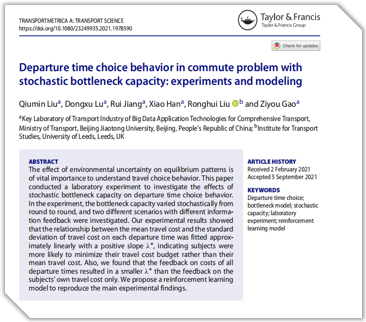
Qiumin Liu, Dongxu Lu, Rui Jiang, Xiao Han, Ronghui Liu, Ziyou Gao. Departure time choice behavior in commute problem with stochastic bottleneck capacity: experiments and modeling TRANSPORTMETRICA A: TRANSPORT SCIENCE.
url:
Citation: Shirui Zhou, Shiteng Zheng, Tu Xu, Martin Treiber, Junfang Tian, Rui Jiang. On the calibration of stochastic car following models. Transportation Research: Part B (2025).
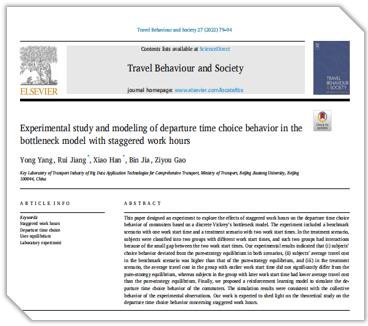
Yong Yang, Rui Jiang, Xiao Han, Bin Jia, Ziyou Gao. Experimental study and modeling of departure time choice behavior in the bottleneck model with staggered work hours Travel Behaviour and Society.
url:
Citation: Shirui Zhou, Shiteng Zheng, Tu Xu, Martin Treiber, Junfang Tian, Rui Jiang. On the calibration of stochastic car following models. Transportation Research: Part B (2025).
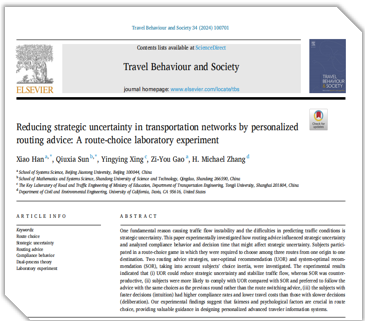
Xiao Han, Qiuxia Sun, Yingying Xing, Zi-You Gao, H. Michael Zhang. Reducing strategic uncertainty in transportation networks by personalized routing advice: A route-choice laboratory experiment Travel Behaviour and Society.
url:
Citation: Shirui Zhou, Shiteng Zheng, Tu Xu, Martin Treiber, Junfang Tian, Rui Jiang. On the calibration of stochastic car following models. Transportation Research: Part B (2025).
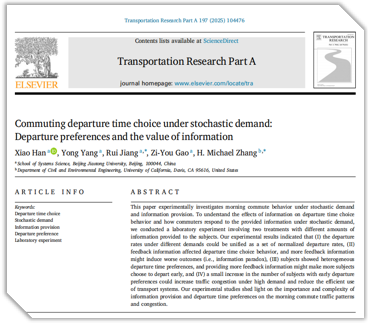
Xiao Han, Yong Yang, Rui Jiang, Zi-You Gao, H. Michael Zhang. Commuting departure time choice under stochastic demand: Departure preferences and the value of information Transportation Research Part-A.
url:
Citation: Shirui Zhou, Shiteng Zheng, Tu Xu, Martin Treiber, Junfang Tian, Rui Jiang. On the calibration of stochastic car following models. Transportation Research: Part B (2025).
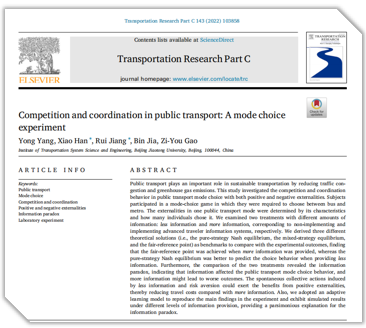
Yong Yang, Xiao Han, Rui Jiang, Bin Jia, Zi-You Gao. Competition and coordination in public transport: A mode choice experiment Transportation Research Part-C.
url:
Citation: Shirui Zhou, Shiteng Zheng, Tu Xu, Martin Treiber, Junfang Tian, Rui Jiang. On the calibration of stochastic car following models. Transportation Research: Part B (2025).
